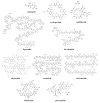Pharmacokinetics of Toxin-Derived Peptide Drugs
- PMID: 30463321
- PMCID: PMC6266565
- DOI: 10.3390/toxins10110483
Pharmacokinetics of Toxin-Derived Peptide Drugs
Abstract
Toxins and venoms produced by different organisms contain peptides that have evolved to have highly selective and potent pharmacological effects on specific targets for protection and predation. Several toxin-derived peptides have become drugs and are used for the management of diabetes, hypertension, chronic pain, and other medical conditions. Despite the similarity in their composition (amino acids as the building blocks), toxin-derived peptide drugs have very profound differences in their structure and conformation, in their physicochemical properties (that affect solubility, stability, etc.), and subsequently in their pharmacokinetics (the processes of absorption, distribution, metabolism, and elimination following their administration to patients). This review summarizes and critically analyzes the pharmacokinetic properties of toxin-derived peptide drugs: (1) the relationship between the chemical structure, physicochemical properties, and the pharmacokinetics of the specific drugs, (2) the major pharmacokinetic properties and parameters of these drugs, and (3) the major pharmacokinetic variability factors of the individual drugs. The structural properties of toxin-derived peptides affect their pharmacokinetics and pose some limitations on their clinical use. These properties should be taken into account during the development of new toxin-derived peptide drugs, and for the efficient and safe use of the clinically approved drugs from this group in the individual patients.
Keywords: dose adjustment; pharmacokinetic parameters; pharmacokinetic variability factors; pharmacokinetics; physicochemical properties; toxin-derived peptide drugs.
Conflict of interest statement
The author declares no conflict of interest.
Figures
References
-
- Provisional BCS Classification Database. [(accessed on 19 October 2018)]; Available online: http://www.ddfint.net/search.cfm.
-
- Captopril Tablets, USP . Professional Prescribing Information. Par Pharmaceutical Companies, Inc.; Woodcliff Lake, NJ, USA: 2012.
Publication types
MeSH terms
Substances
LinkOut - more resources
Full Text Sources
Other Literature Sources


